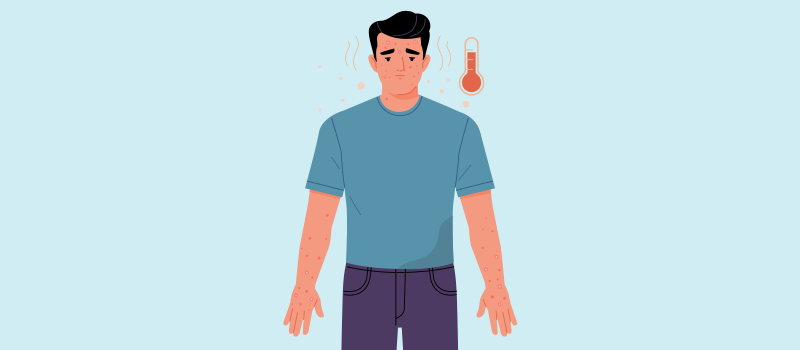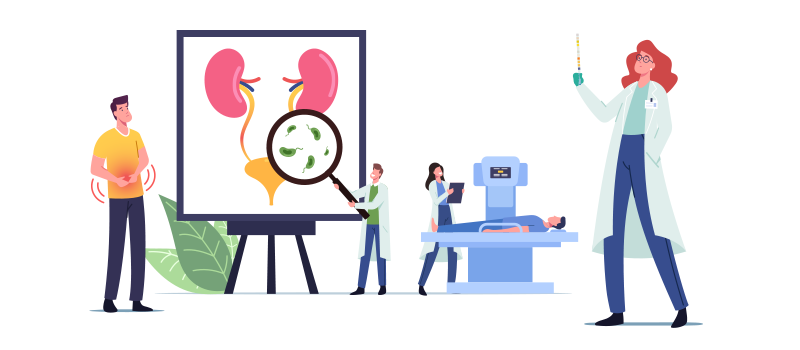What’s the Buzz
The Bee Healthy Blog
HIV Symptoms in Men: Signs to Look For

Key Takeaways
-
HIV is a sexually transmitted viral infection that affects white blood cells. HIV attacks the immune system, making patients with this condition more vulnerable to developing repeated infections.
-
HIV is known to cause a few specific symptoms in men, including low sex drive, erectile dysfunction, penile ulcers, proctitis, and prostatitis. Early symptoms can include flu symptoms.
-
While there is no cure for HIV, proper treatment can help an HIV-positive person live a long and healthy life. Taking certain precautions can also lower the chances of transmitting HIV to others.
HIV (human immunodeficiency virus) is a sexually transmitted viral infection. Being aware of how to prevent the spread of HIV and the early warning signs of this infection can help patients avoid serious complications like acquired immunodeficiency syndrome (AIDS).
Continue reading to learn about the common HIV symptoms in men and the signs that they should look for in order to get an early diagnosis of this condition.
What is HIV?
HIV is a virus that predominantly affects white blood cells called lymphocytes CD4. These cells play a crucial role in creating an immune response against infections.
As HIV attacks the immune system, patients with this condition are more vulnerable to developing repeated infections.
HIV typically spreads through sexual contact. HIV is passed from one infected person to another through blood, vaginal fluids, semen, breast milk, and anal mucus. However, the virus is not passed on by sneezing, spitting, or coughing.
Most signs and symptoms of HIV are similar to those of several other acute and chronic conditions. Hence, it is often difficult to detect this condition. But, there are a few signs that point to the possible diagnosis of HIV, especially when they recur frequently.
What are the common signs and symptoms of HIV?
Most symptoms of HIV are similar in both men and women. Some common signs of HIV include:
-
Skin rash
-
Fever with chills
-
Extreme or unusual fatigue
-
Sore throat
-
Mouth ulcers
-
Pain and aches in muscles
-
Swollen lymph nodes
What is AIDS?
AIDS (acquired immunodeficiency syndrome) denotes the last stage of HIV infection.
A person is said to have developed AIDS when the HIV has caused significant damage to the immune system, preventing the body from fighting off most infections.
As a result, the patient may develop a wide range of symptoms that tend to progress over a period of time.
Some common signs of AIDS include:
-
Extreme fatigue
-
Rapid weight loss
-
Pneumonia
-
Diarrhea that persists longer than a week
-
Memory loss
-
Sores in the mouth, genitals, or anus
-
Recurrent bouts of fever, usually with severe night sweats
-
Red, purple, pink, or brown blotches on the skin
What are the main symptoms of HIV in men?
HIV is known to cause a few specific symptoms in men. These symptoms predominantly occur due to the involvement of the male reproductive system, urinary system, and immune system.
Low sex drive
There are several causes for a low sex drive in men. However, low sex drive can be a sign of HIV-associated hypogonadism. Hypogonadism occurs when the testicles fail to produce an adequate amount of testosterone, the male sex hormone.
Some other signs of hypogonadism that could be associated with HIV include:
-
Erectile dysfunction
-
Infertility
-
Fatigue
-
Reduced hair growth on the face and body
-
Abnormal growth of breast tissue
-
Usual fatigue
-
Depression
-
Mood swings or low mood
Erectile dysfunction
Erectile dysfunction (ED) refers to the inability of a man to get or maintain an erection.
Erectile dysfunction is a common sign of HIV in men. It is estimated that 13 to 86% of men with HIV experience difficulty in getting an erection. Erectile dysfunction can affect the sex life of men and lead to the loss of sex drive.
It may also affect their personal relationships and contribute to poor emotional health, resulting in a higher risk of depression.
Penile ulcers
HIV can cause painful open sores and ulcers on the penis, usually in combination with the enlargement of the lymph nodes in the groin region.
These lesions often take longer to heal and tend to recur frequently. In addition, men may also develop ulcers and sores on the mucosa of the oral cavity and esophagus. Sores can also appear on the anus.
Proctitis
Proctitis is inflammation of the rectum. Infectious proctitis can occur frequently in men with HIV who have sexual contact with other males.
Some common signs of infectious proctitis include abnormal anal discharge, continuous feeling of having a bowel movement, anorectal (anus or rectum) pain, constipation, and rectal bleeding.
Prostatitis
Prostatitis is the inflammation of the prostate gland. Infectious prostatitis can occur when a man has unprotected sex with a person having a sexually transmitted infection such as HIV, gonorrhea, or chlamydia.
This condition is characterized by symptoms such as pain and burning while passing urine, increased frequency of urination, pain during ejaculation, and passing bloody or cloudy pee. Pain in the testicles, penis, bladder, and the area between the rectum and scrotum is also a typical sign of prostatitis caused due to sexually transmitted infections.
It is important to note that the male-specific symptoms mentioned above can also occur due to other conditions. Therefore, if you notice these signs, you should consult a healthcare practitioner to get an accurate diagnosis.
What are the symptoms of acute HIV infection?
The early stage of this infection is called primary or acute HIV. It marks the period when the HIV virus enters some white blood cells. The virus multiplies rapidly at this stage to make billions of copies of itself, which spread throughout the body.
During this period, the person has a higher chance of spreading the virus to others due to the significantly higher viral overload in the body fluids.
Although the symptoms of HIV develop gradually and become worse over a period of time, there are a few early signs that patients may notice within a few weeks after they are infected.
Early HIV symptoms often resemble flu-like symptoms and occur as a result of the body’s natural response to the virus. The initial symptoms of acute HIV infection in men during this stage include fever, extreme and unexplained tiredness, headaches, skin rashes, sore throat, loose motions, pain in the muscles and joints, and swollen lymph nodes.
However, it is important to note that not all men with HIV experience flu-like symptoms. Some men do not experience any noticeable symptoms and feel completely normal during this period.
What are the late-stage HIV symptoms?
HIV infection primarily affects the functions of the immune system. Once the immune system is compromised, the virus spreads at a slower rate. This stage is known as clinical latency or chronic HIV infection. In most cases, men do not have any symptoms during this period.
Without appropriate and early treatment, the clinical or chronic latency stage typically lasts 10 to 15 years. However, with regular treatment such as ART (antiretroviral therapy), this stage can persist for decades with a significantly reduced risk of serious complications. Proper treatment can help an HIV-positive person live a long and healthy life.
How is HIV infection diagnosed in males?
Your doctor might recommend a few blood tests to diagnose or rule out HIV/AIDS. Some common blood tests used for HIV testing include:
Antibody test
Antibody tests take 23 to 90 days to detect HIV following exposure to the virus. This test can be performed using HIV rapid test kits.
Antigen-antibody test
This HIV test looks for the presence of antigens and antibodies of HIV in the blood. This test can help to detect HIV within 18 to 45 days after exposure to the virus.
Nucleic acid test (NAT)
This HIV test is recommended for people who have had possible exposure to HIV recently, especially if they have any flu-like symptoms. This test can detect HIV within 10 to 33 days after exposure.
What are the HIV treatment options?
The main treatment for men with HIV infection is ART (antiretroviral therapy). ART involves a combination of HIV medicines. It is important to note that ART cannot cure HIV infection. However, it can help patients live longer by lowering their risk of serious complications as the infection progresses.
HIV Symptoms in Men: Frequently Asked Questions
How do you know if a male has HIV?
Some common signs of an HIV-infected man include abnormal swelling, sores, and ulcers in the penis, mouth, and anus, recurrent bouts of diarrhea, and unusual fatigue. The gradual decline in general wellness and a history of rapid weight loss also point to the possible diagnosis of HIV.
HIV testing is recommended in case a male has one or more of these symptoms.
How long does it take for HIV symptoms to show up in men?
The first signs of acute HIV infection usually appear within 2 to 4 weeks after exposure to the virus. However, some men may not have any symptoms.
What are some tips for HIV prevention?
There are several important ways to prevent HIV transmission between people. To minimize your chances of contracting HIV, be sure to follow these tips:
-
Get tested for HIV before sex.
-
Avoid using contaminated or used needles.
-
Get tested and treated for any STI (sexually transmitted infection).
-
Use protection such as condoms during sex.
-
Use HIV prevention medicines, such as pre-exposure prophylaxis (PrEP) and post-exposure prophylaxis (PEP).
What are the main symptoms of HIV in men?
Early HIV symptoms in men can be flu symptoms. Some common symptoms of HIV in men include erectile dysfunction, loss of sex drive, penile ulcers, hypogonadism, proctitis, and prostatitis.
References:












SOCIAL